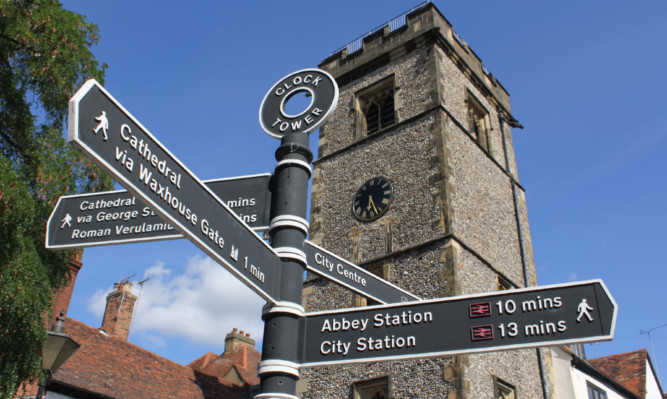
You will not want for places of refreshment in St Albans.
There are probably more pubs, restaurants and cafes in the city than in any other comparable space and they often either face each other across the street or sit side-by-side on the same road.
And credit to the landlords most of their establishments are colourfully bedecked with floral arrangements.
Not just one or two hanging baskets, troughs and window boxes, but dozens of them. A vivid, eye-watering explosion of planting.
St Albans today is a dormitory town, home to thousands of commuters so property prices are a pretty penny. But for us curious tourists, it’s also steeped in custom and history and is still full of charm.
If you come by rail, the 300 bus outside the station will take you right into the city centre the bonus is that it goes through some lush countryside en route.
A real insight into the community’s history and antiquity came at the Verulamium Museum, just down the hill from the cathedral and around the corner from St Michael’s Street.
Their ‘How to find us’ leaflet says that the museum is 10 minutes walk from St Albans city station, but I would suggest that if that’s the case, it must have been Usain Bolt doing the walking.
Luckily, that reliable old 300 bus goes right past it.
Verulamium is, of course, the old Roman name for their settlement here. The museum is fairly new and built and shaped very much like a bath house.
Inside are some eye-boggling artefacts, huge stretches of mosaic recovered from ancient villas, tools that tradesmen used, their pots and lots of sculptures.
While you are down in the Roman area, take in St Michael’s Church, parts of which date back to the 10th Century, and which stands on the site of the basilica.
It is more than likely that the Roman soldier Alban (from whom the city gets its modern name) was tried and executed right here.
He is the first Christian martyr, beheaded in 324AD on the orders of the Emperor Diocletian, who did not share the young man’s faith.
St Michael’s has a fine monument to Sir Francis Bacon, the politician, scientist and writer.
It was Bacon who was created the first Baron Verulam, and later Viscount St Albans and it is he who, some scholars have claimed, had a large part in the writing of many of the plays attributed to William Shakespeare.
A few yards away is one of the most complete Roman amphitheatres in northern Europe or at least, the foundations of it and also of a villa and some shops.
It was here that the citizens of Verulanium would gather for the big events sacrifices, drama, meetings, early forms of pantomime and maybe animal and gladiatorial games.
Now it is on private land, so a £2 coin has to change hands and you are allowed to wander at will past the rooms where the actors changed and on the banks where the spectators sat. It is big. Very big.
It is a slow hike back up to the Cathedral and Abbey Church of St Alban which, amazingly for cathedrals these days, offers free entrance for visitors.
There has been a church here since 793AD and it has been a favourite building of mine for many years. Well, most of it.
Because a zealous Victorian called Edmund Beckett, the first Lord Grimthorpe, who was described as a “pompous, righteous bully”, got his clammy hands on it.
Grimthorpe effectively took over the sympathetic repair and alternation work being carried out by the inspirational George Gilbert Scott on Scott’s untimely death and imposed his own ‘vision’ of ghastly Gothic on a building that, in part, dates back to 11 years after the Norman conquest.
We can raise a prayer of thanks now that he didn’t do more harm than he did.
At the time, the locals of St Albans even coined the phrase “to Grimthorpe”, which meant to undertake expensive, unsympathetic restoration work!
Across the way is the imposing St Albans School, a rather posh minor public institution that boasts (among other things) that it is the only school in the English-speaking world to have educated a Pope Adrian IV.
The impressive clock tower, the only medieval belfry in England, dates from the 15th Century and was used to sound the town curfew until late into Victoria’s reign.
The best tip of all, apart from wearing sensible walking shoes, is that the route of that 300 bus is nothing short of a Godsend!
Report by Phil Penfold

Enjoy the convenience of having The Sunday Post delivered as a digital ePaper straight to your smartphone, tablet or computer.
Subscribe for only £5.49 a month and enjoy all the benefits of the printed paper as a digital replica.
Subscribe